Imagine a kitchen filled with the comforting aroma of freshly baked gluten free sourdough bread, the crisp golden crust yielding to the soft crumb within. If you have wanted to learn how to bake sourdough sandwich bread, this is an incredible, easy recipe!
This post may contain affiliate links. Please read our Disclosure Policy.
Serve this with my Curried Chicken Salad, Unstuffed Pepper Soup, or Instant Pot Chicken Vegetable Soup.
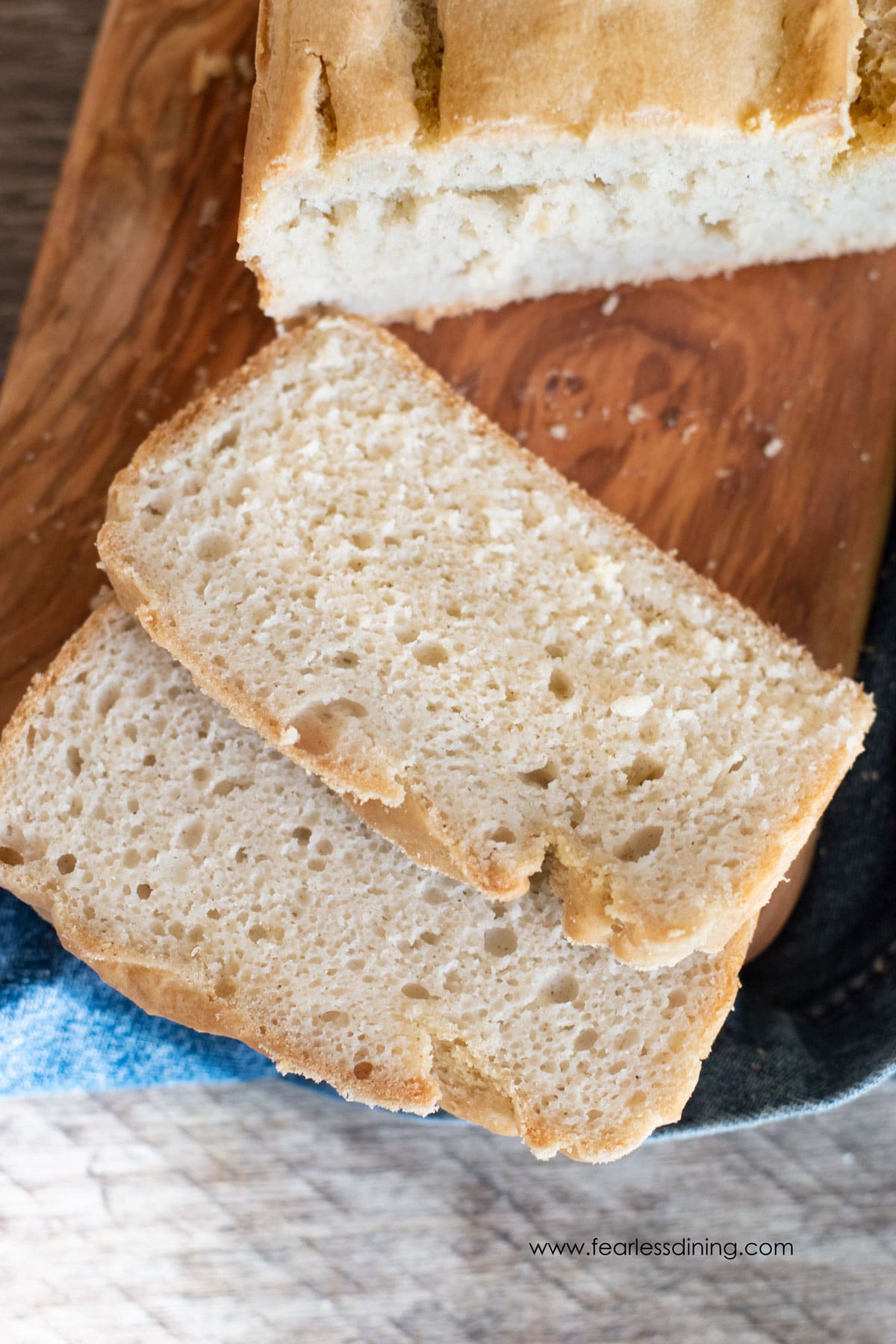
Would you like to save this recipe?
🔑 Sandi says: This post was updated and reorganized from an older 2014 post. I included a lot more tips from myself and readers to help you make this recipe with success. This is a recipe that I recommend you read the entire post.
There is nothing better than the taste of fresh sourdough bread! It is seriously (or should I say Srsly) the most incredible comfort food! This original recipe comes from Sadie, founder of the famous Bread Srsly in San Francisco. Please know this recipe is not her current recipe, as she has tweaked it over the years, but it turns out incredibly! (I have also streamlined this recipe since she first shared her recipe with me back in 2014.)
Sadie used a combination of millet, sorghum, brown, and white rice flour in her original recipe. Many of us don’t have a lot of individual flours on hand…so it was important for me to simplify the ingredients. This is an excellent introduction if you want to try making a version of Bread Srsly’s famous sourdough bread.
Allergen Information:
This sourdough bread is also egg-free, dairy-free, nut-free, soy-free, and completely vegan, so it is perfect for those with food allergies!
If you love baking gluten free bread as much as we do, check out my delicious gluten free bread recipes.
I made this bread last night with Bob’s Redmill GF all purpose flour with my GF starter & it came out amazing!! So happy I found this recipe & can’t wait to make it again!! This recipe was very easy to follow & the tips were very helpful.
wendy, blog comment
Do This First:
Go to my How to Make a Gluten Free Sourdough Starter page and make your gluten free starter! Do this first because there is no sourdough bread without an active starter!! For a list of tools you need, please read my article on Sourdough Tools.
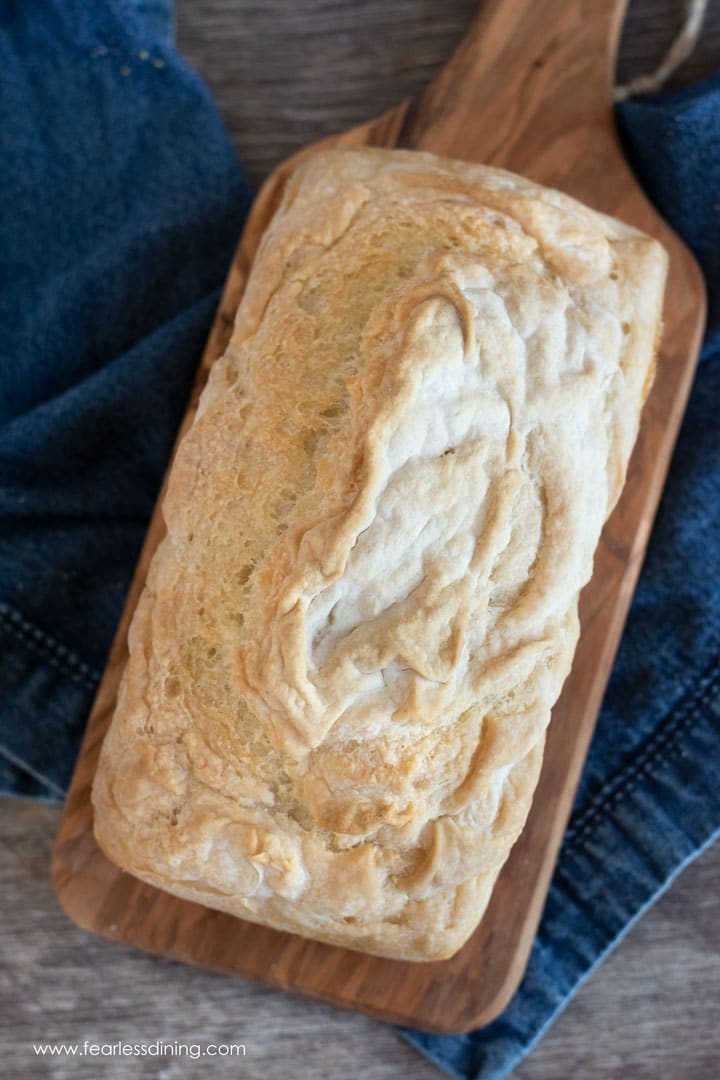
A Note on Gluten Free Flour Blends:
I have tested several different gluten free blends. I talk a lot about King Arthur Measure for Measure, which is a standard blend. I also used a very starch-heavy gluten free flour blend by GF Jules. Both performed very well.
The main difference is the texture of the bread on the inside. Both had a nice crusty outside. GF Jules was much lighter and fluffier on the inside, while the King Arthur flour blend loaf was a little more hearty, like regular sourdough bread.
Many of my readers have chimed in with different flour blends they have tried in the comments, so I encourage you to keep reading through everyone’s comments. Dana loved Bob’s Red Mill 1 to 1 Gluten Free Blend with this recipe.
Reader Rave
I made mine with Krusteaz Gluten Free 1 to 1 flour, and it turned out great. I will definitely be making it again. Thanks for the tips on buttering the top and baking with water/steam. The crust is perfect.” Veronica R.
Step-By-Step Photos and Directions:
We are finally ready to make this gluten-free sourdough bread loaf! Are you as excited as I am?
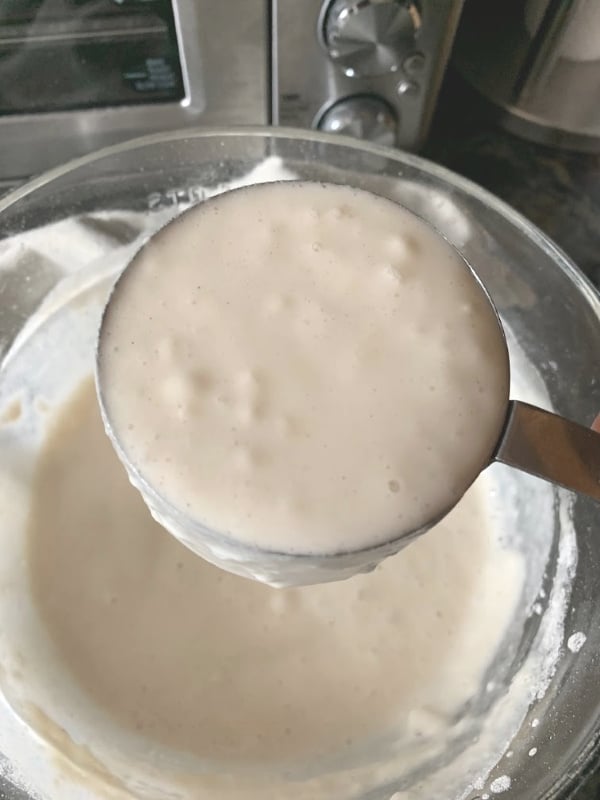
Step 1: You will need 3/4 cup of gluten free starter. Make sure it is bubbling and at room temperature! If you refrigerate your starter, take it out of the refrigerator the night before you plan to make bread. I take a discard, feed it with gluten-free flour and water, and let it sit on the counter overnight.
You will want your starter warmer if it is a cold season, especially winter. I like to put my starter either in the oven with the light on or on my Euro Cuisine Yogurt Maker base (with two folded dish towels on it so the starter doesn’t get too hot.)
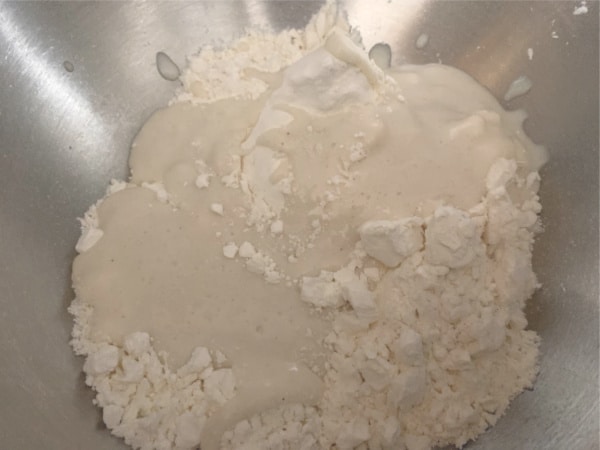
Step 2: Put the gluten-free flour and salt into a large
Why Water Quality Is Important:
I always use purified water when making sourdough or baking with yeast. Chlorine and chemicals in our tap water can kill your yeast and inhibit the rise. If you want the best rise, you must use purified water that doesn’t contain these chemicals.
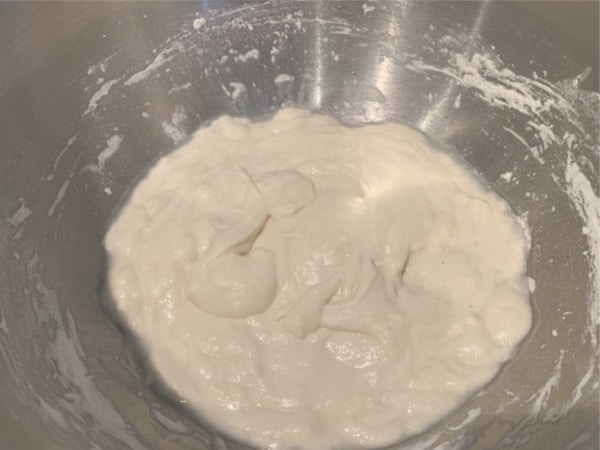
Step 3: Mix the wet and dry ingredients well. You want a wet dough, like a thick pancake batter.
Step 4: Cover loosely with plastic wrap and let the dough rise for 3 hours (go by how big it rises). I then gently move the dough to a greased bread loaf pan and let it sit for another 3-4 hours. If you are not using a metal pan, you can do the whole rise in the bread pan!! Cover with a damp towel so the dough doesn’t dry out.
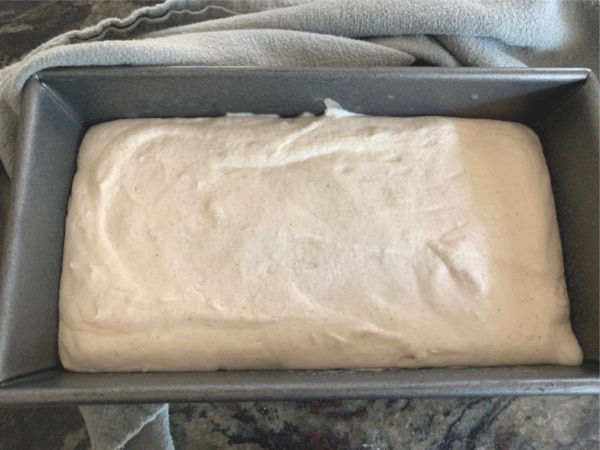
This is my favorite option so far – let it rise in the pan you’ll use for baking and it has the softest crust and best crumb of the four 5 recipes I’ve tried, while still being super easy.”
Sara K.
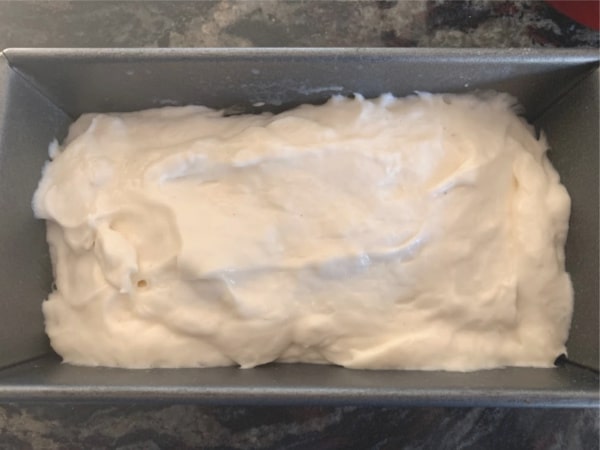
Note that the King Arthur Measure for Measure was a little runnier in consistency. The GF Jules has a much higher starch content and looks much fluffier!
Step 5: Bake the gluten free sourdough loaf for 45 minutes at 425º F. I noticed it hadn’t browned on top – so I brushed the top with melted butter at the 45-minute mark and then quickly closed the oven door.
Hurry when gently brushing the melted butter on- the longer the oven is open, and the rack pulled out a bit – will lose a tiny bit of its rise. Once the oven is closed again, the rise comes back quickly.
Step 6: Bake for another 30 minutes and test the bread with a probe-style thermometer showing 200-210º F in the center. Note: the bake time will vary depending on the size and depth of the pan you bake your bread in.
If you notice that the thermometer has a bit of residue on the probe, you can turn off the oven and leave the loaf in the oven to cool so it finishes baking and cooling more gently to keep as much of the final baked-in rising and fluff.
Step 7: Carefully move the bread to a cooling rack. Cool the bread completely before removing it from the pan and slicing it with a serrated bread knife. You want the bread to cool for a minimum of 3-4 hours before slicing it.
Read my Gluten Free Bread Troubleshooting Guide for more tips and possible troubleshooting.
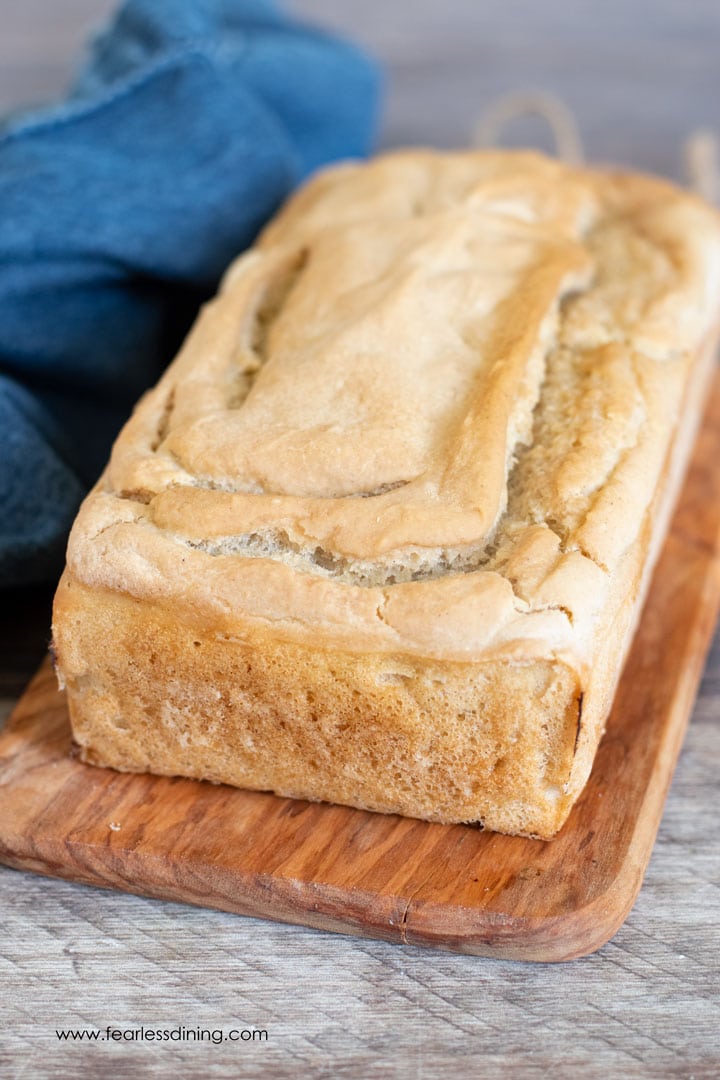
How to get crusty bread:
If you love crusty bread, try this artisan Gluten Free Sourdough Boule recipe! I also love this Gluten Free Cranberry Walnut Sourdough Bread.
I highly recommend baking this bread with a pan of hot water to create steam. Sadie at Bread Srsly didn’t do this, but I found baking with hot steam creates a really good crust to the bread.
To get steam, you can fill a shallow baking dish with very hot water and put it on the bottom rack in your oven when you turn the oven on. Keep it there the first hour your bread bakes.
You can also bake your sourdough in a Dutch oven. Keep the lid on for the first 30 minutes of baking.
Frequently Asked Questions:
Store it the right way! Learn How to Store Gluten Free Bread so you can keep it fresh.
No, regular sourdough is not gluten free because it is made with wheat flour. If you are gluten free, you need to use gluten free flour to make your starter and bread.
If you want to speed your rise a little, add 1-2 teaspoons of sugar. Many of my readers have used 1 teaspoon of soda powder mixed in. I added 1 teaspoon of sugar to the GF Jules mix before adding it to the bread loaf tin, and it seems to have risen higher and kept the rise through baking better.
In the early days of gluten free baking, there were few choices in flour or blends. Many people didn’t know Bob’s 1:1 wasn’t recommended for yeast recipes, so they used it. Bob’s 1:1 does work in this recipe. Why not, with so many readers using it with good success?
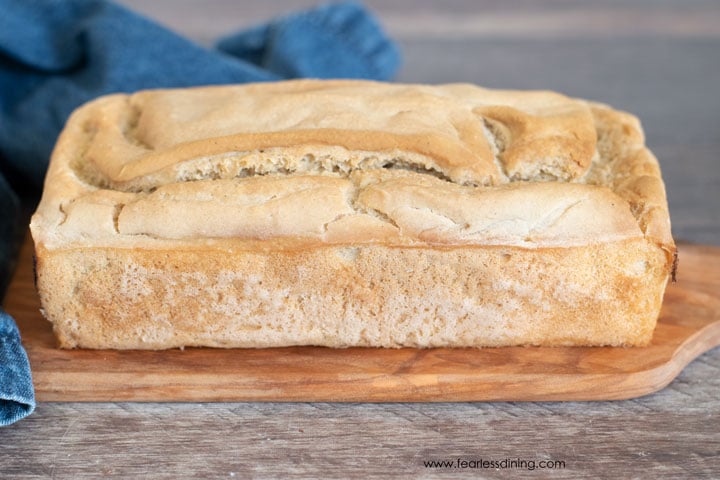
Reader Tips:
I am including many reader tips. There is so much experience in perfecting bread. I encourage you to read the tips and comments section.
It was a pleasure at each step- because it was an adventure. Not everyone is that enthusiastic, I know. But, for someone whom has zero experience in gluten free baking – this brave trial was easy and enjoyable.”
Dana
I am new to gf sourdough bread baking, and each loaf is improving. Only the first was a complete fail due to stickyness. I mix my dough in the a.m., and mid afternoon, I mix a 2 T. boost of flour, 1/4 c. of water and 1 tsp of baking soda, add that into the dough and move the dough into my loaf pan for a fairly quick rise. I bake at 400F for an hour after dinner for use the next day. I check temp with a probe for 200+F. I don’t use steam and crust is cruchy/chewy. I’ve used center of oven and low center without noticing a difference. Some tips that may work – fluff flour with fork before measuring, and mix with a fork, too. You can cover your loaf pan with a second for the ride to allow room and protect. Some bake like this to simulate a Dutch oven, but I’ve not tried it yet. If I use the baking soda, it really helps the rise and opens the grain. Otherwise it is fairly sense and short. I am wondering how to reduce stickyness more. I am thinking a different flour may help. I have been using Wal-Mart GF All Purpose and BRM in the red bag. Both have some starches. I usually toast my bread slice and that dried them a bit, too. This has been a fun adventure, and we’ve enjoyed discard pancakes, too.
Chris, reader comment
I successfully babied a sorghum starter for several weeks feeding it regularly and discarding only occasionally until it matured. I have found the process to be not as finicky as it is usually presented and is quite forgiving. I have since made 4 successful loaves of various kinds of gluten free bread, baking once a week and keeping my sourdough in the refrigerator during the week, bringing it out the night before I plan on using it and feeding it. I always make mine with a stand mixer and beat it for 3-4 mins before putting it into a loaf pan forming it with a wet silicone spatula. I always use bottled or spring water in my recipes as chlorine kills bacteria, therefore living sourdough. If I am in a hurry to bake, I add 1 tsp of baking sofa to my loaf. It reacts with the acidic sourdough and causes a faster rise. If I am not, I practise patience…not my finest asset! Sometimes rise may take anywhere from 12-48 hrs for the dough to double in size. Because I live in the great white north, I also always put my bread in the oven with the light on to rise. I oil the top of my loaf lightly with olive oil and place a kitchen towel over it. Once it is fully risen I remove it from the oven and heat my oven to 450. I put the loaf in and then decrease the temperature to 420 for 20 mins. This gives a beautiful chewy crust. Then I decrease my oven again to 375-400F and bake for 30 minutes until the interior loaf measures above 205F. Let it cool completely before slicing up the loaf. Store in the freezer taking out what you will use, defrosting in the microwave until warm. This recipe makes fantastic sandwiches! I use this method with all the loaves I have made and it works great! Hope this helps!
Lois M., reader comment
We’ve accidentally left out the salt a few times at the bakery, and we found that the bread did not rise as much as a salted dough! It was really interesting, and not at all in line with the baking rules I know. The key to getting your recipe down is the balance between water, binder, and bake time. Too little water means the dough can’t stretch enough to take full advantage of the binder. Too little binder, and the water will just make it harder to bake, with less rise because there isn’t enough elasticity. Too low a bake temp means that the amount of oven spring will be small.
Sadie, responding to a reader question about salt
I make mine in a crock pot! I line to crock with oiled parchement and let raise 12-24 hours. Cook on high for 2.5 hours. The top doesn’t brown and isn’t pretty, but it still tastes the same as baking it. Plus it doesn’t heat up my kitchen in the summer!”
Jill H., Pinterest comment
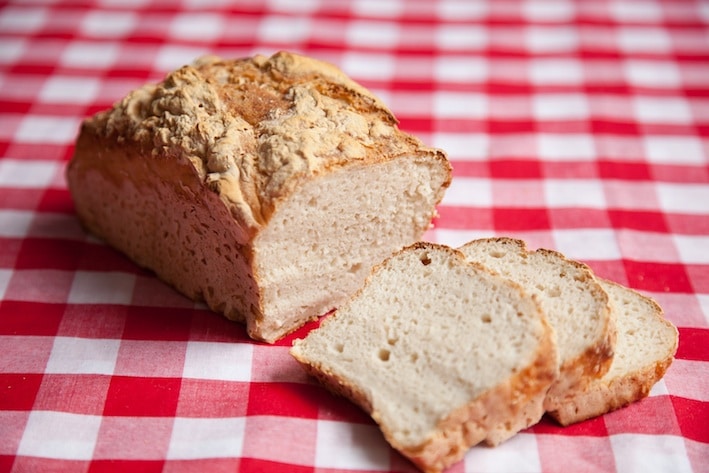
Serve Gluten Free Sourdough Bread With:
If you haven’t eaten a lot of sourdough bread or are looking for some ideas on what to serve it with, here are a few tasty ideas:
- Roasted Chicken – Place pieces of roasted chicken and cheese (if you can tolerate dairy) and toss them under the broiler until it is hot and the cheese is bubbly. Add toppings and enjoy. So good!
- Bread Crumbs – You can dry the loaf of sourdough bread and turn it into bread crumbs. It will go lovely in any recipe that requires bread crumbs, and the flavor is terrific. Try this delicious Gluten Free Meatloaf recipe!
- Dip – Serve pieces of gluten free sourdough with this Hot Cream Cheese Dip, which will go perfectly! It pairs nicely with anything cheese-based too.
If you love gluten free bread, you will want to try these Gluten Free Cheddar Herb Muffins recipes, too. They are so light and fluffy. Also, these Paleo Biscuits are delicious and perfect for anyone who needs to be grain-free!
Sadie’s Original Recipe:
Here is the recipe that Sadie gave me back in 2014, untweaked. Several readers still use this recipe, so I wanted to include this in my article. This is the quote from Sadie, who used a millet, rice, and sorghum flour blend. The salt and xanthan gum are not used in the starter but in the bread:
- Mix equal parts of the flour of your choice and water. Avoid using pure starches like tapioca, corn, or potato starch.
- Leave it in a bowl at room temperature, covered by a towel. Add a little more flour and a little more water every 8-12 hours (2-3 times per day).
- After 3-5 days, the mixture should start to smell sour and have some bubbles. Congratulations, you’re almost there.
- Once your mixture is bubbling, add a little bit to your bread mix. Do not use any yeast. Let this rise for at least 12 hours.
- Once the dough has risen, it will be your sourdough starter! Use a little bit of this dough in a fresh batch of dough.
- You’ll be impressed at how vigorous your sourdough can be.
- Always save a cup or so of your last dough to use as a starter in your next batch.
- Keep it in the fridge, and be sure to “feed” it with fresh water and your blend of flour from the bread recipe at least once a week, but twice if you can.
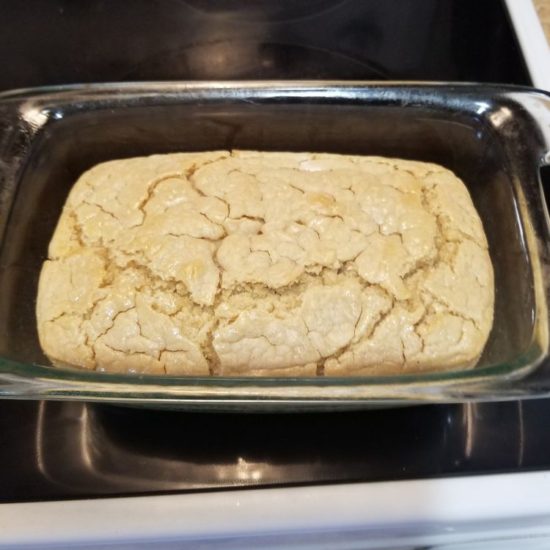
If you want to try another great sourdough recipe, give this Gluten Free Sourdough Bagels recipe a try! If you want to make incredible gluten free bread quicker, try my delicious Gluten Free Bread Machine Bread recipe! If you have discard to use up, try my Gluten Free Sourdough Discard Biscuit recipe!
Love This Recipe?
If you made and enjoyed this recipe, I would be incredibly grateful if you could leave a comment below. Please include which flour blend you used. This will help others know this recipe is delicious. Thank you!
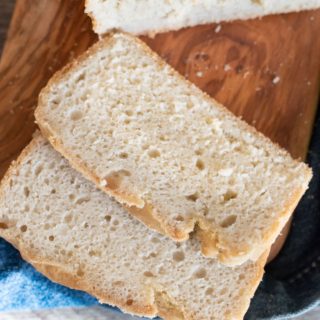
Gluten Free Sourdough Sandwich Bread
Ingredients
- 2 cups gluten free flour blend * see note
- 1 teaspoon kosher salt
- ¾ cup sourdough starter
- 1 cup water by feel You will need more or less depending on the flour blend you use.
Would you like to save this recipe?
Instructions
Do This First:
- PLEASE read the whole recipe post I wrote about making this gluten free sourdough sandwich bread because it is loaded with tips from me and other readers. It is impossible to put them all in this recipe card.
- Go to my How to Make a Gluten Free Sourdough Starter page and make your gluten free starter! Do this first because there is no sourdough bread without an active starter!!
Make The Bread:
- You will need 3/4 cup of active gluten free starter. Make sure it is bubbling and at room temperature! If you refrigerate your starter, take it out of the refrigerator the night before you plan to make bread. I take a discard, feed it with gluten-free flour and water, and let it sit on the counter overnight.
- You will want your starter warmer if it is a cold season, especially winter. I like to put my starter either in the oven with the light on or on my Euro Cuisine Yogurt Maker base (with two folded dish towels on it so the starter doesn't get too hot.)
- Put the gluten-free flour and salt into a large non-metal mixing bowl and whisk together. Add the sourdough starter and filtered water.
- Note: It is important to use filtered water. Tap water has a lot of chemicals, including chlorine, which can kill your yeast and decrease the rise.
- Mix the wet and dry ingredients well. You want a wet dough, like a thick pancake batter.
- If your bowl isn't metal, cover it loosely with plastic wrap and let the dough rise for 3 hours (go by how big it rises). It may look lumpy, but that is okay. Let it- don’t overwork- you are eliminating the rise with every stroke. I move the dough to a greased bread loaf pan and let it rise for another 3-4 hours. Cover with a damp towel so the dough doesn't dry out.
- Note that the King Arthur Measure for Measure was a little runnier in consistency. The GF Jules has a much higher starch content and looks much fluffier!
- Bake the gluten free sourdough loaf for 45 minutes at 425º F. I noticed it hadn’t browned on top – so I brushed the top with melted butter at the 45-minute mark and then quickly closed the oven door.
- Bake for another 20-30 minutes and test the bread with a probe-style thermometer. The bread should be between 200-210º F in the center. Note: the bake time will vary depending on the size and depth of the pan you bake your bread in.
- Carefully move the bread to a cooling rack. Cool the bread completely before removing it from the pan and slicing it with a serrated bread knife. You want the bread to cool for a minimum of 3-4 hours before slicing it.
Notes
- Read the entire post. You will miss a lot of tips and tricks in making this recipe a huge success.
- I have tested this recipe with King Arthur Measure for Measure and GF Jules blends. Readers have tested this recipe with Nameste, Krusteaz, and Bob’s Red Mill 1:1.
- Note this is a recipe that came from Sadie at Bread Srsly. She has many tips in the article and 100s of reader comments filled with tips.
- Store the bread in an airtight container. I always recommend slicing and freezing the bread slices if you are not going to eat the loaf quickly. Freeze when the bread is fully cooled in a freezer-safe zipper bag.
How to get crusty bread:
I highly recommend baking this bread with a pan of hot water on the lower rack in the oven to create steam. (Sadie at Bread Srsly didn’t do this, but I found baking with hot steam creates a really good crust to the bread.) To get steam, you can fill a shallow baking dish with very hot water and put it on the bottom rack in your oven when you turn the oven on. Keep it there the first 30 minutes that your bread bakes.SPECIAL NOTE
Please know that every gluten free flour blend has a different starch to grain ratio. If you use a blend I didn’t test, you may need to adjust your moisture levels in your baked goods.
Nutrition
Nutrition Disclaimer
Nutritional information is an estimate provided to you as a courtesy. You should calculate the actual nutritional information with the products and brands you are using with your preferred nutritional calculator.

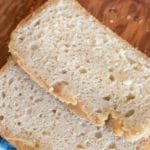
Hi Sandi! I made this bread using the recipe you have for gluten free all purpose flour mix and the sourdough came out SO tasty and deliscious but a little dense/not fluffy. I followed all your steps very closely and was wondering if you had any suggestions for adjustments I can make for next time so my bread rises a bit more/ is more fluffy? Could it be the lack of xantham gum in the flour mix? (I don’t like to bake with gums so I was hoping to avoid it!) Or do you recommend allowing the dough to rise somewhere warm (my house was very cold when I made the bread last weekend)? Love your blog and all your recipes!!! Thanks!
Hi Roisin, it will be easier for me to help if I know a few more details like what flour blend did you use, what did you add for a binder, how long it rose, how active your starter weas, and what temperature you rose the bread at. Thank you.
Hi Sandi! Thanks for the quick reply. I used the 1:1 flour recipe on your blog (https://www.fearlessdining.com/easy-gluten-free-all-purpose-flour-blend/#recipe), but I did not add a binder. I wasn’t sure I should since there was psyllium husk powder. I let the bread rise for 16 hours (but it didn’t rise very well). The starter was very active, I had been feeding it at a warm temp for a few days prior. And for the temperature I let it rise at – I left the bread in the oven with the light on since my house is very cold. So about 60-70 degrees I would say! Thanks!!
Hi Roisin, I am confused. You mentioned you used King Arthur, but you used my 1:1 blend recipe? I want to make sure I understand so I can best advise you. Did you maybe use the KA to make the starter and my homemade blend to make the bread? Also, are you at a high altitude?
Hi Sandi, no I didn’t use KA- I didn’t think I said that but apologies if I did/caused confusion! I used your all purpose flour blend with no added binder. And I am not at a high-altitude. To make the starter I used brown rice flour. Thanks!
Hi Roisin, It sounds like you did things right. You mentioned a cold house, so maybe warm your oven to 175-200º F and very loosely cover the bread pan with plastic wrap. Let it rise there. I find this helps a lot, especially in the winter.
Could this be shaped into a round boule loaf?
Hi Andrea, This recipe is specifically made as sandwich bread.
I made this bread last night with Bob’s Redmill GF all purpose flour with my GF starter & it came out amazing!!
So happy I found this recipe & can’t wait to make it again!! This recipe was very easy to follow & the tips were very helpful. This was my first attempt with this recipe and it was a great success. I tried another recipe prior to this one and it came out like a brick!!
Hi Wendy, I haven’t tried that blend in this recipe, so I am very glad to hear it worked well. Thank you!
Do you have this recipe somewhere in grams? It is so much easier to weigh and get things right in grams. I don’t use measuring cups in GF bakes anymore.
Thanks
It isn’t my recipe, it came from Sadie, so I do not have gram measurements.
Added smoked salt, shredded cheddar, and chopped jalapenos to this recipe, let set for 24 hours, then cooked on high in my crockpot for 25 hours. SOooooo good!!
This sounds incredible Jill. Can I ask more about how you cooked it in your slow cooker? I am so intrigued.
I appreciate the recipe and the directions but one thing I didn’t see. Did all your flours contain xanthan gum? Many of the flours I have don’t have it and there’s not always clear information on how much or whether to add it. That information would be very helpful.
Hi Ruth, this recipe has been tested with multiple flour blends by multiple readers. The majority of the flour blends tested do contain xanthan gum. I can’t test every flour blend in every recipe, it would be very expensive for me given I provide my recipes to everyone for free. If you prefer gum free, you can use my DIY gluten free flour blend https://www.fearlessdining.com/easy-gluten-free-all-purpose-flour-blend/
Hi!
I have started my sourdough starter and I’m trying to make sure I have everything in order to make bread. Is there a flour blend you’d recommend above them all?
Hi Lainey, I would recommend Jules GF flour blend. I really liked how it turned out when I made this bread.
Just finished my first gluten free loaf using your recipe (waiting for it to cool)! So excited! I have a recipe clarification question: after the 12-24 hour rise, do you then add more flour and water for a final rise? And do you add sugar or soda in the first rise or the second? Thanks! (I used Bob’s gluten free 1:1 flour)
Hi Chita, sorry for the late reply. We lost power and probably won’t get it back for 3 more days here in the SF Bay Area. I would add the sugar in the first rise. Add flour as needed for texture.
Have you ever tried this with caputo gluten free flour? It’s an amazing new flour I found from Italy and I wonder if you could get the loaf to form better with this flour. I’m just following your recipe for the first time and don’t have enough experience to try yet! But I’d be curious since it acts so much like normal flour when it bakes!
Hi. Unfortunately, my stomach doesn’t do well with wheat starch so I am not able to test this flour blend.
Antimo Caputo gluten-free flour (and it says “Fioreglut”) is what I think Jazz was asking about. I see they sell it on Amazon for gluten free pizza crust, pasta and breads.
And I LOVE your recipes!
Thank you for all of them.
GM
Just a note that the Caputo is not safe for those with a wheat allergy. There are some with Celiac, including myself, who can’t eat wheat starch.
This is really good and dense! My only problem is that I forget it needs a long rise. 😂
I am glad you enjoyed this recipe. Let me know how it goes next time with a longer rise.
Question. Is there a way to make this a cinnamon sourdough bread loaf? I have my grandfather’s recipe but it calls for yeast and since i have found out that I have celiac and can no longer make his German sourdough it breaks my heart. His you do have to roll out so just wasn’t sure if I needed to add more flour and the baking instructions. Thanks.
Hi Robyn, My gluten free sourdough recipe makes more of a loaf-style bread and it isn’t that workable by hand. My best thought to add cinnamon and sugar is to put 1/3 of the dough into the pan, add cinnamon, top with some dough and repeat to get cinnamon layers. There is a gf sourdough FB group you may be able to get better help with a loaf that you can shape.
I have made this bread several times now and really like it but for some reason the inside of my loaf is always sticky. Do you have any idea why?
Hi Lisa, can you give me more details? What flour did you use for your starter, what gluten free flour blend are you using to make the bread? How long are you baking it, etc?
I have a sourdough starter For baking regular Bread from my Daddy ( this batch since 2003) but have never had success making GF Bread or Buns/Rolls from it ‘Hope You can help’ ?
How cool that starter has been around since 2003!! I wish I could advise you. If it isn’t a gluten free starter, I am not sure how to advise. I have never used a non-gf starter and I am not sure how it behaves versus a gluten free one. There is a gluten free sourdough Facebook Group, I advise asking there.
Has anyone tried using this recipe in a bread machine?
Hi Deanna, I am unaware of anyone using a bread machine with my recipe. If you do try it, please come back and let us know how it turns out.
I am going to try this in my bread machine and will let you know here how it turns out. This is a fabulous recipe and I have made it successfully before in a boule shape. But my last two bread attempts have not fared so well.
Please do let me know. Thank you Jeri!!
Do you have the original recipe that was posted here? I made it for years and knew it by heart.
Was it Millet, sorghum, white rice flour, xanthum, salt?
Thanks!!
Hi Charlotte, This is the quote from Sadie, who used a blend of millet, rice, and sorghum flours. The salt and xanthan gum are not used in the starter but they are in the bread: Mix together equal parts a flour of your choice and water. Avoid using pure starches like tapioca, corn or potato starch. Leave it in a bowl at room temperature, covered by a towel. Every 8-12 hours (2-3 times per day) add a little more flour and a little more water. After 3-5 days the mixture should start to smell sour and have some bubbles. Congratulations, you’re almost there. Once your mixture is bubbling, add a little bit in to your bread mix. Do not use any yeast. Let this rise for at least 12 hours. Once the dough has risen, it will be your sourdough starter! Use a little bit of this dough in a fresh batch of dough. You’ll be impressed at how vigorous your sourdough can be. Always save a cup or so of your last dough to use as a starter in your next batch. Keep it in the fridge, and be sure to “feed” it with fresh water and your blend of flour from the bread recipe at least once a week, but twice if you can.”
After you let the dough rise for 12-24hrs, you suggest adding some more water and flour to feed the dough. How much do I add? Thanks 🙂
Hi Lise, I add enough to make the dough less liquidy then put it into the loaf pan. You can see the texture of the dough in the photos. The exact quantity will depend on the flour blend you used and how starchy it is. I hope this helps.
Has anyone used an egg in this, or maybe apple cider vinegar, to make this rise more or not be so dense?
I sometimes add egg when I am using the starter for pizza crust, hopefully someone will respond for you.
The flavour of this bread blew me away! So excited to have something that actually tastes like bread since going GF. Still tweaking my recipe as I didnt get a lot of time in my bread before or during baking but it was still edible, maybe just more like a trumpet in texture compared to bread. And it was so tasty! I wrapped it in foil overnight and cut some the next morning to have for lunch at work. Cut and buttered two slices and put in zip lock bag. BUT the bread was so dry! I was so disappointed as it was so good the day before!! Any tips?? Do I need to keep it in the fridge?? Or could it have to do with the rise/baking issue??
Using a pretty starchy blend as that is all I can get locally in Aus.
Hi Sam, I am glad you are enjoying the flavor of the bread. I want to make sure I understand. Are you saying the bread was dry after the Ziplock or dry after wrapping in foil overnight?
Hi,
Is it possible to make this recipe in a boule form?
Hi Darienne, this is really more of a loaf style. To make it boule form, you need to add more flour so the dough is workable with your hands…it also requires different baking instructions. I highly recommend checking out the Gluten Free Sourdough FB group for boule recipes.